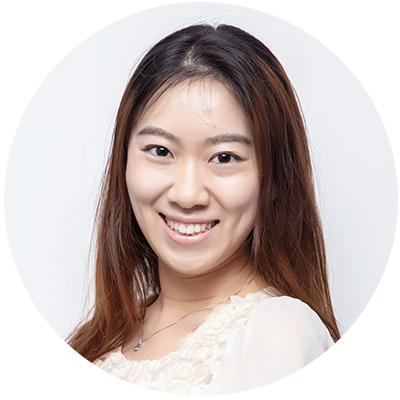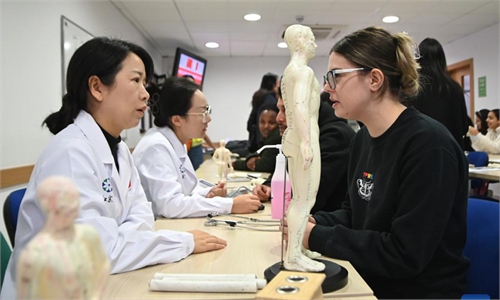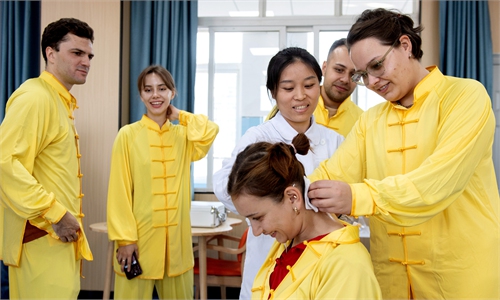IN-DEPTH / IN-DEPTH
Healing in China: Russian fans flock to border city to experience millennia-old wisdom of traditional Chinese medicine
Cross-border wellness
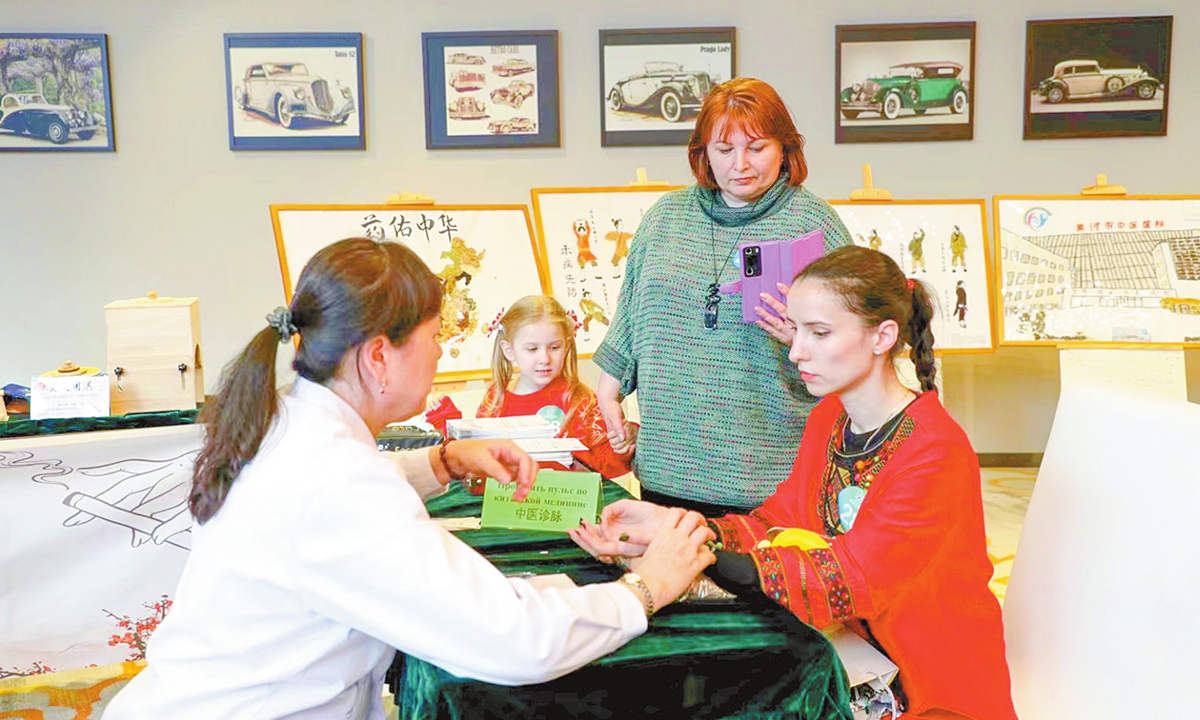
A Russian patient undergoes TCM pulse diagnosis in Heihe, Northeast China's Heilongjiang Province on May 18, 2024. Photo: VCG
Editor's Note:Amid the "China Travel" trend, the number of international travelers visiting China continues to increase. Many international visitors are now turning their attention to China's efficient and distinctive healthcare system. From its advanced modern medical services and the global appeal of traditional Chinese medicine, to the growing popularity of medical tourism, "China Hospital" has become a trending topic online, serving as a new option for many international patients.
In light of this, the Global Times is launching a three-part series titled "Healing in China," which will explore the various aspects of how the country's healthcare system is attracting patients from around the world and gradually transforming into a popular global destination for medical services. This is the second installment in the series.
In a sunlit room at the Heihe Hospital of Traditional Chinese Medicine in Northeast China's Heilongjiang Province, 56-year-old Sergei from Russia's Blagoveshchensk - winces slightly as the Chinese doctor's fingers press along his spine. Suddenly, a series of "gaba gaba" cracks echo through the room. Sergei's eyes widen, then he gives an enthusiastic thumbs-up. "It's like pressing a reset button for my body!" he exclaims, his Russian accent mingling with the warm aroma of burning moxa drifting from the next room.
For Sergei, this isn't just therapy - it's a cultural adventure, a bridge between his Siberian roots and the warm, mysterious world of Chinese healing.
This scene - part therapeutic ritual, part cultural spectacle - is routine at the hospital, where Chinese medicine meets Russian curiosity. Along the hospital's corridors, the air is perfumed with the faint aroma of mugwort, and bilingual Chinese-Russian signs guide patients to clinics adorned with traditional decor. Upstairs, in the international clinic, a group of Russian patients study a Russian-language poster explaining Baduanjin, a set of eight gentle exercises rooted in traditional Chinese medicine (TCM) to boost energy flow and balance.
A cross-border TCM craze
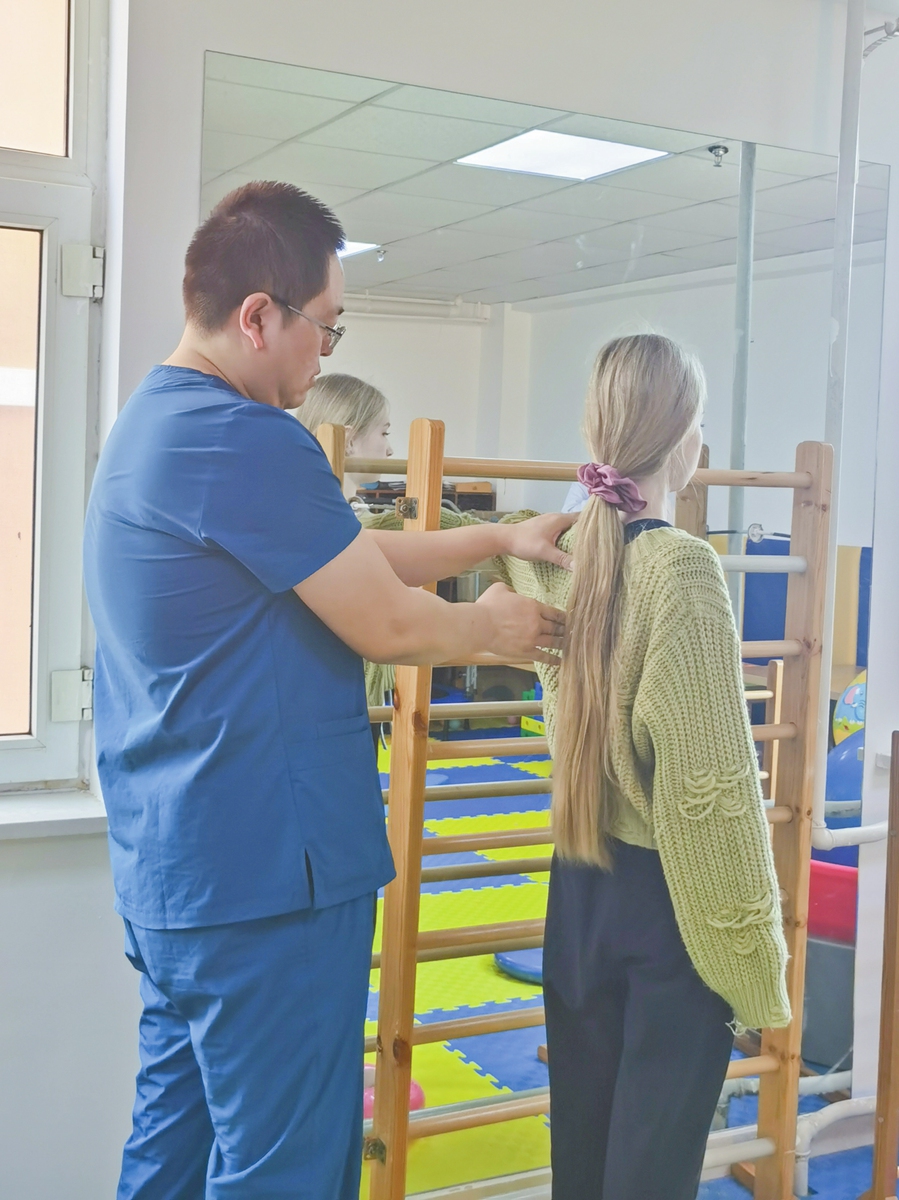
Chen Xuejia demonstrates rehabilitation techniques to treat 14-year-old Chistokhina Sosiya Valeryevna from Belogorsk on May 22, 2025. Photo: Hu Yuwei/GT
"In 2024, we treated over 600 Russian patients using TCM techniques like acupuncture, cupping, and other TCM treatment protocols, issuing more than 300 prescriptions for Chinese herbal medicine," Han Bing, deputy secretary of the Party branch at the Heihe Hospital of Traditional Chinese Medicine, told the Global Times.She noted that nowadays, Russians are no longer just seeking cures for chronic pain. "Now they come for wellness - to balance their 'qi' and prevent illness," Han notes. "Many Russian patients especially enjoy experiencing cupping. It's something they have rarely seen before. When they see the marks left by the cups, they find it intriguing. After cupping, their muscle soreness is relieved, and they think it's just incredible!"
Living in the chilly Far East, where heavy coats don't always fend off dampness, Russians often suffer from "dampness" in TCM terms, characterized by rheumatism, neck pain, and joint issues. Patients with stroke and cardiovascular and cerebrovascular diseases are also among the main groups choosing TCM treatment. "Their trust in TCM is growing," Han said. "After treatment, they bring friends and family."
Han added that women in Russia's Far East often suffer from arthritis due to wearing thick upper clothing with bare legs, while high-cold regions face more hypertension. Western medicine typically uses pills or injections, but people in China and abroad are increasingly conscious of health maintenance.
Since around 2014, the number of Russian patients has surged in Heihe. To keep up with growing demand, the hospital launched an International Medical Department in 2024, training staff in Russian and hiring translators to provide full-process escort for Russian-speaking patients in need during medical visits and medication pickup, Han revealed.
Han also emphasized that these services are provided free of charge, and the hospital's consultation fees are consistent for all patients regardless of nationality, without charging international patients higher prices.
Dou Manyou, the hospital's Russian-speaking publicity chief, plays a key role. He preps patient histories, coordinates treatments, and teaches colleagues TCM terms in Russian - how to explain "dampness,"or "liver qi stagnation" so patients grasp TCM's logic, not just its remedies. "It's about making the experience seamless," Dou said, flashing a smile as he shares a new Russian phrase in the hospital's work chat.
Trust builds bridges. "Once they feel the difference, they bring their entire family," Han emphasizes. The trend began quietly around 2015, but exploded after the hospital established its International Medical Department. Now, staff like Dou act as cultural and linguistic translators. "How do you explain 'liver qi stagnation' in Russian? We use diagrams of energy pathways and compare it to 'emotional blockages,'" he says, flipping through a bilingual glossary.
From 'oriental magic' to affordable reality
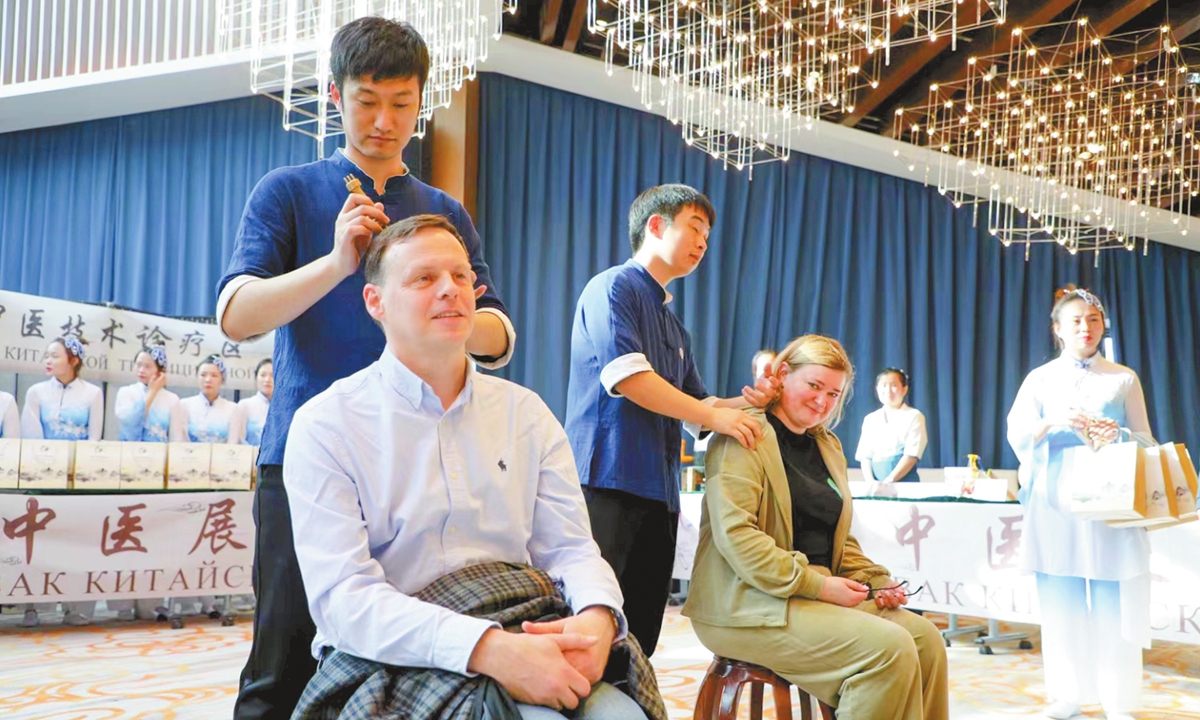
Russian citizens experience traditional Chinese massage in Heihe on May 18, 2024. Photo: VCG
In a therapy room, 14-year-old Chistokhina Sosiya Valeryevna from Belogorsk, Russia, lies calmly on a therapy bed as doctor Chen Xuejia performs tuina massage to aid her recovery from a stroke-induced limp. There is no trace of fear or concern on her face. She's already showing signs of improvement after just three days of therapy, according to her mother. Chen even recorded a reference video to help guide her home exercises, ensuring progress continues across the border.The mother beams as she shares her family's love for TCM. "My mother cured her migraines with TCM years ago," she told Global Times. "I didn't hesitate to bring Sosiya here."
In Russia, TCM's buzz is growing, and Heihe's appeal is practical: A 30-minute border crossing from Blagoveshchensk, affordable lodging, and treatments that cost half what they would in Moscow. With deepening China-Russia ties - streamlined visas, expanded flights, and historically warm relations - cross-border TCM trips are easier than ever.
The mother gives a thumbs-up mid-conversation, her enthusiasm infectious. "Most Russians are straightforward," Dou explained. "If they come, they trust you completely."
Social media has helped fuel the craze. On VK, Russia's top social media platform, "Heihe TCM" is a hot topic. A post about acupuncture curing decades-long insomnia sparked threads asking for cross-border ferry schedules.
In 2023, the hospital invited Russian journalists to produce a three-minute TCM culture video, now looping on Amur region's TV, social media platforms, and outdoor screens, introducing more Russians to TCM's charm.
Heihe's TCM hospital has also taken the initiative to build its international reputation. Han told the Global Times that to promote TCM culture, the local government invites international delegations to participate in study tours or inspection visits at the hospital when they come to Heihe, allowing them to experience what TCM truly is.
In recent years, the hospital has organized "going global" activities, such as a free medical clinic for over 100 Russian patients in Blagoveshchensk. During these events, it demonstrated TCM therapies like guasha (scraping), ear acupressure, and moxibustion to help locals understand TCM, hoping to benefit more people with China's quintessential medical heritage. It also partnered with a rehabilitation center in Yuzhno-Sakhalinsk, Russia, to open a TCM experience center, sending four staff members to offer tuina massages.
Meanwhile, portable TCM innovations like granulated herbs and remote pulse diagnosis let Russians take "home TCM" back with them.
Beyond Heihe, TCM is spreading into Russia's Far East: Kamchatka's spas now offer moxibustion, Vladivostok's pharmacies stock Chinese herbs, and Yuzhno-Sakhalinsk's yoga studios teach Baduanjin, according to media reports.
Gaining popularity worldwide
Scenes like these at the event reflect the growing global recognition of TCM for its unique strengths in disease prevention, control, and rehabilitation. Data shows that TCM has spread to 196 countries and regions, with more than a third of the world's population having received TCM treatment, the Xinhua News Agency reported.
Over the years, the Chinese government has worked closely with the World Health Organization (WHO) to integrate traditional medicines more comprehensively into the global health system.
China has signed TCM cooperation agreements with over 40 governments, regional authorities, and international organizations. A total of 30 high-quality overseas TCM centers have been established in countries participating in the Belt and Road Initiative.
Meanwhile, the WHO has included traditional medicine, with TCM as the mainstay, in the 11th revision of the International Classification of Diseases, according to Xinhua.
Traditional medicine plays an important role in helping achieve universal health coverage, and TCM has much experience for the world to draw from, said Martin Taylor, the WHO representative in China.
As the sun sets over the Heilongjiang River, known in Russia as the Amur River, Sergei exits the hospital, clutching a bag of herbal teas. "In Russia, we have pharmacies; here, they have healers," he says, grinning.
Down the corridor of the hospital, new arrivals across the border flip through Russian guides to TCM meridians. The "gaba gaba" cracks of spine adjustments blend with the clinking of herb jars.
For these Russian seekers, the "Oriental force" isn't magic. It's a journey across a river, a needle pricking skin, a herb's earthy aroma, and the quiet certainty of healing, like the Heilongjiang River flows.
